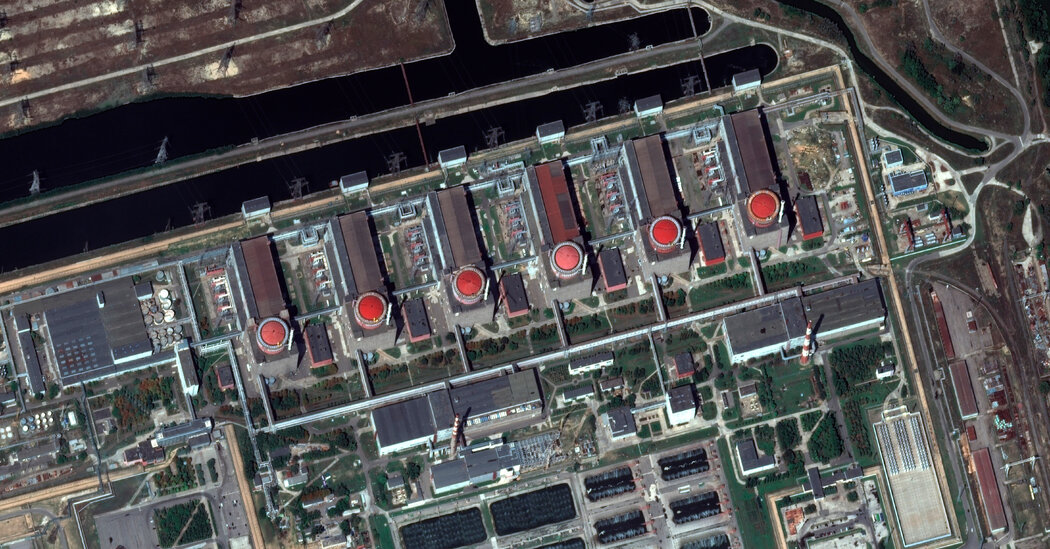Why inspectors haven’t yet visited the Zaporizhzhia nuclear plant.

BRUSSELS — With anxiety mounting about the dangers to Ukraine’s largest nuclear power plant, which is occupied by the invading Russian Army, there finally seems to be some movement to get international inspectors into the facility to verify its safe operation.
In a conversation late Friday, President Vladimir V. Putin of Russia told his French counterpart, Emmanuel Macron, that Russia “had reconsidered” its insistence that inspectors from the International Atomic Energy Agency first travel through Russian territory to reach the Zaporizhzhia plant, according to the French presidency.
The Russian presidency was less explicit, stating that “both leaders noted the importance of sending an I.A.E.A. mission to the power plant as soon as possible” and that Russia had “confirmed its readiness to provide the necessary assistance to the agency’s inspectors.”
The two presidents will speak again about such a mission “in the next few days following discussions between the technical teams and before the deployment of the mission,” the French said.
The I.A.E.A. — the United Nations’s nuclear watchdog and monitoring agency — has met with several obstacles in its discussions with Russia and Ukraine to get into the Zaporizhzhia plant, Europe’s largest, since at least June.
Our Coverage of the Russia-Ukraine War
- Trading Accusations: Russian and Ukrainian militaries accused each other of preparing to stage an attack on the Zaporizhzhia nuclear plant. The United Nations, issuing warnings of the risk of a nuclear disaster, called for a demilitarized zone around the plant.
- Crimea: Attacks by Ukrainian forces have tested security on the Black Sea peninsula, which was illegally annexed by Russia in 2014 and has become a vital staging ground for the invasion.
- Odesa: With the focus of the fighting shifts to southern Ukraine, it has become clear that this Black Sea Port, a personal obsession of President Vladimir V. Putin, is the big prize in the war.
- Clandestine Resistance: Ukrainian guerrilla fighters are spotting targets, sabotaging rail lines and killing those deemed collaborators as they seek to unnerve Russian forces.
Ukraine objected to the idea that the inspectors would enter through Russian-occupied territory, an option that would seem to underscore Russian control of the plant, which provides at least a fifth of Ukraine’s electricity. The United Nations had significant security concerns about having inspectors travel through the front lines of this bitter war, with so much shelling.
As Russia and Ukraine blame each other for bringing the possibility of nuclear catastrophe to the plant through the artillery war — part of what a senior Western official on Friday called “the information war” — pressure has grown on Moscow to relent about the how the inspectors might arrive.
That pressure has also come from Turkey, which has tried to mediate between Russia and Ukraine on the issue, as it did in the recent deal to free grain shipments from Ukraine’s Black Sea ports amid a Russian blockade, and from the United Nations itself.
When António Guterres, the United Nations secretary general, visited Ukraine this past week along with President Recep Tayyip Erdogan of Turkey to discuss grain shipments, the U.N. leader also urged quick movement to try to keep the Zaporizhzhia plant safe.
Mr. Guterres warned Russia not to disconnect the facility from the Ukrainian grid, as Kyiv says Russia intends to do, in order to switch the supply into the Russian grid. Such a move could interrupt the vital cooling of the reactors and cut electricity to millions of Ukrainians.
Western officials consider the main danger of a nuclear accident coming less from a shell hitting one of the containment buildings around the six light-water nuclear reactors, which are constructed to withstand a 9/11-like impact of an airliner, than from an interruption in electricity. Should that happen, and should the plant’s generators fail or be damaged, then a meltdown could occur.
The main concern in that respect, a senior Western official said on Friday, would be if the plant suffered a loss of cooling due to the loss of backup electricity, should Russia take it off the Ukrainian grid and should backup generators fail.
There is also worry that a shell could hit one of the ponds that store spent nuclear fuel, but that would have a more minor and localized effect.
Russia has rejected the plea of Mr. Guterres to demilitarize the area around the plant.
On Friday, the I.A.E.A.’s director general, Rafael M. Grossi, “welcomed recent statements indicating that both Ukraine and Russia supported the I.A.E.A.’s aim to send a mission” to Zaporizhzhia.
The Russian ambassador to the agency has suggested that such a mission could take place in early September. But even if inspectors can verify the safety of the plant at the time, the dangers will inevitably persist as the artillery war continues.
